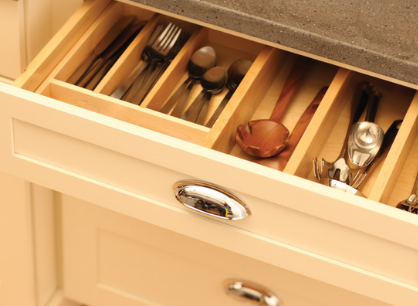They say that the key to organization is to have everything in one place and to have everything in place. This is true for even the smallest items, such as kitchen utensils. These include your everyday utensils as well as many small but powerful cooking tools that a serious chef needs. Here are some of my favorite options for storing utensils in any space and on any budget.
Step 1: Elimination

Before you’re able to properly organize any part of your home, you’ll need to do some culling, especially in the kitchen. Drawers can quickly fill up with unused tools and gadgets, so take a closer look at what you have and find as many as you can to give or box.
You may never be able to reduce your cutlery collection to the perfect minimal arrangement shown in these photos, but the more items you can eliminate, the easier it will be to store and find really useful items. Never use the small dessert spoon that came with the cutlery set? Have you only used that particular spatula (designed to perfectly flip a single egg) once? Store these items in hard-to-reach spaces, such as upper cabinets, to free up more space for quality cabinets.
If You’re Going to Renovate, Make a Plan for Success

If you are going to renovate or build a kitchen, you should not postpone organizational considerations until all the construction is complete. Thinking ahead about how to hold the tools you collect will yield better results. Planning to add some drawers dedicated to the size of the cutlery will save a lot of space that could be wasted.

The typical cutlery tray is not very wide. Your basic utensils will be used every day, but they don’t need that much space. Drawers that are only 10 to 12 inches wide will provide proper space for these items without having them share space with blenders and ladles.
Think Deeply

In addition to considering the width of the drawer, don’t forget to consider the depth. By default, drawers are typically 6 to 8 inches deep (on the outside surface) for the simple reason that cabinets are evenly divided into three to four drawers. However, a 4 to 5 inch deep drawer (again on the surface, i.e., only a few inches inside) is enough to store neat cutlery. Using more and shallower drawers can prevent items from piling up and getting lost.
Ideally, you should look at the collection of appliances you own (or plan to have) and map out exactly how much space they need. This requires a little extra effort upfront, but you’ll end up with a better allocation of space than simply choosing a drawer of any width. You can try placing cutlery on the dining table to get a visual idea (and some measurement) of their ideal space size.
Mix Drawers and Doors

People often think of a chest of drawers and a basic shelf cabinet as two separate things, but they can definitely be mixed together to meet your needs more effectively. Cabinets with drawers at the top, doors and shelves below can place smaller, frequently used items at a more accessible height, while shelves can store more occasional and oversized items. If you use a lot of small chef tools while cooking, consider adding many cutlery drawers on the top floor. Over time, it will reduce the number of times you bend over.
Consider Vertical Use

Want to organize your cutlery drawers without having to assign a separate place to each cutlery? Try using drawers with vertical cutlery boxes so you can easily put utensils with long handles, such as spatulas and slotted spoons, in and out easily. You will be able to see each piece, and later you will not have to remember exactly where it was obtained.

This style of cabinetry can make the most of the small spaces left in the cabinet plan, such as the small space next to the stove or sink.

You can also store utensils vertically. The deeper drawer is cleverly transformed into a cutlery drawer, dividing it into small, deep compartments like this. Make sure you don’t store sharp items in this way, as this may blunt the blade (and there is also a risk of accidents).
Create a Layer

Another way to make the most of deep drawers is to divide them into layers on the inside. You can use the built-in drawer separation system or find the tiered recessed units.
A layered organizer like this can create smaller compartments than a single drawer for maximum space efficiency. Keep in mind that the upper layer will partially cover the lower layer (or will need to be slid separately), so you should place the most frequently used items on the most accessible layer.
Retrofits: What Are the Options?
Of course, many of the images in this article use beautiful built-in custom trays that may not always be an option, especially when using existing cabinetry. However, there are many alternatives to choose from.
Individual Pallets

Sometimes you just need a classic single cutlery tray, but keep in mind that these trays aren’t really one-size-fits-all. Finding a tray that is close to the width of the filling drawer will provide more structure than a small tray that moves with use. Measure the inside of the drawer and look for a tray that can fill the drawer. Online stores often have more size options than small local kitchen supply stores.
Configurable Pallets

One step on top of the prefabricated individual pallets is a divider system made up of individual compartments that can be mixed and matched like Tetris, creating space for all your belongings. If you can’t fit the entire width perfectly, use an open space to place sturdy items, such as rolling pins or foil boxes, to keep other pieces from moving.
Resizable Partitions

Another step closer to customizing the built-in is an resizable partition system like this one, which lets you combine individual pieces together to create a compartment of any size you like. One advantage of this system is that you can change the configuration later to accommodate different combinations of items, and even install new drawers when moving or renovating.
Open Storage Containers

For those who don’t mind displaying some utensils, a simple open container or jar is a great place to store frequently used items. This looks especially great in kitchens that already use open shelves, and utensils jars become part of the chef’s overall kitchen appeal.

I love the way this kitchen wraps open storage containers around a small tray, giving it a subtle sense of organization. It’s a small detail, but it makes the eclectic tool feel collectible and neat.
Suspension Rails

Another form of open locker is a rail, which can be used to hang cutlery and tools directly (by bending handles or hooks) or to hang containers and holders, keeping your cutlery within reach but away from the counter.
The wall-mounted system is great for taking up a little storage space behind the hob or elsewhere on the backsplash, which is a lifesaver for compact kitchens where every inch of storage is important.
Pegboard

Just like railings, pegboards can give you plenty of flexible storage space on the wall. Whether the look is glamorously relaxed or overly hectic is a matter of personal taste, but if you like the aesthetic, it offers many practical options for arranging and rearranging your tools.


